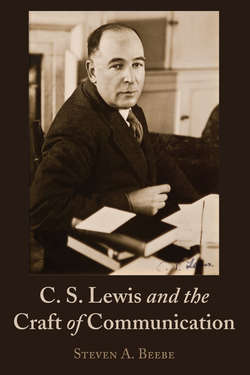Читать книгу C. S. Lewis and the Craft of Communication - Steven Beebe - Страница 20
На сайте Литреса книга снята с продажи.
HI TEA: A Preview of Lewis’s Communication Lessons
ОглавлениеIn the next chapter we will look more closely at Lewis’s life to provide a context for understanding Lewis as communicator. Many of his early experiences were traumatic. The death of his mother when he was nine, the series of inept boarding schools he attended, and his brief, harrowing foray into World War I were life-challenging experiences that influenced both the content of his messages and the way he connected to others. He knew pain and thus he could write about its problem. He observed grief yet wrote about Joy surprising him. Perhaps it is his own, sometimes eccentric but always interesting, life that continues to add to his mystique. Lewis lived a compartmentalized life in the sense that few people saw the “complete Lewis.” He had secrets. He kept his marriage to Joy Davidman hidden from his friend J. R. R. Tolkien for a period of time. Michael Ward develops the widely-supported theory of Lewis’s compartmentalization based on the fact that Lewis embedded a theme within The Chronicles of Narnia. Lewis, argues Ward, wanted to make this hidden theme implicit to all and explicit to none.116 C. S. Lewis remains both enigmatic as well as a focal point of interest, in part because of his multifaceted life experiences. Although it is true that Lewis’s writing evidence common themes, as a person Lewis was sometimes secretive and complicated.
As his popularity as an author continues unabated, C. S. Lewis remains a person of great interest. Original Lewis letters are in high demand. (A one-page Lewis letter sold at auction in London in 2018 for $5,700. Another two-sided letter, ←19 | 20→written in 1952, is for sale with a suggested price of $46,000.)117 A first edition of some of his harder-to-find books can sell for tens of thousands of dollars.118 But the question many continue to ask is “Why?” Why do people continue to be enamored with his work? And more to the point of this book: What makes Lewis a successful communicator as evidenced by his continued book sales? What did he know about the craft of communication? What were his techniques of connecting to readers and, through his radio broadcasts and lectures, listeners?
Although many excellent biographies about Lewis exist, none comprehensively explore how Lewis’s life experiences shaped his communication principles and practices.119 The discipline of communication encompasses a wide array of concepts, variables and skills. Specifically, communication is the process of making sense out of the world and sharing that sense with others by creating meaning through the use of verbal and nonverbal messages.120
There have been excellent summaries of selected elements of Lewis as communicator, but they typically focus on either his speaking skill, writing skill, or rhetorical applications. The book C. S. Lewis: Speaker and Teacher, published in 1971 edited by Carolyn Keefe, presents a clear description of his speaking skills from those who heard him (including a detailed analysis of his voice), but it does not highlight his overarching communication principles.121 Others have written about his literary skill or his rhetorical insights.122 Gary Tandy’s well-written book The Rhetoric of Certitude: C. S. Lewis’s Nonfiction Prose123 offers considerable insight about Lewis as rhetorician, as does James Como’s excellent Branches to Heaven: The Geniuses of C. S. Lewis.124 Lewis scholar Greg Anderson’s insightful essay “A Most Potent Rhetoric: C. S. Lewis Congenital Rhetorician” is a tour de force describing Lewis’s rhetorical gifts.125 Another well-researched book, C. S. Lewis and the Art of Writing by Corey Latta, describes Lewis’s skill as an author.126 Yet little has been written about his overall approach to and application of communication principles. One exception is the comprehensive doctoral dissertation by Terry Lindvall that provides an excellent summary of Lewis’s observations about communication from a broad perspective.127 My efforts here are to draw upon these excellent previous summaries, as well as Lewis’s own work, to present a comprehensive discussion of Lewis as communicator, not just as rhetorician, teacher, broadcaster, or speaker. My goal is to highlight Lewis’s mere (essential) communication principles that help explain his popularity and continued presence in so many academic and literary genres, including communication. Although Lewis did offer explicit advice about writing and communication, including the unfinished Language and Human Nature that he planned to write with J. R. R. Tolkien, he did not develop a cogent set of principles in any single work. The principles ←20 | 21→presented here are not explicitly articulated by Lewis as his “five principles of communication.” Nevertheless, his insights into and applications of principles of effective communication found throughout his work make the identification of these principles possible. Before highlighting each principle in a separate chapter, we begin by providing background information about his life and “big ideas.”
Chapter 2 explores more fully how Lewis’s life experiences shaped his communication talents. In order to be an effective communicator, it is imperative to have something to say. Chapter 3 examines the major themes and big ideas in Lewis’s works. Owen Barfield, Lewis’s friend, financial executor, and fellow Inkling, noted that all of Lewis’s key themes were present in whatever Lewis wrote.128 So it is important to understand these ideas to appreciate his ability to communicate them.
After the opening chapters provide background and set the stage for a discussion of Lewis’s key communication ideas, chapters four-eight then present five core principles, one for each chapter, that constitute the essence of Lewis’s understanding of communication. Each of the five principles can be cogently summarized with one word: Holistic (Chapter 4), Intentional (Chapter 5), Transpositional (Chapter 6), Evocative (Chapter 7), Audience (Chapter 8) which form the acronym HI TEA. Here’s a preview of these five principles that provide the core concepts of Lewis’s communication ideas.
